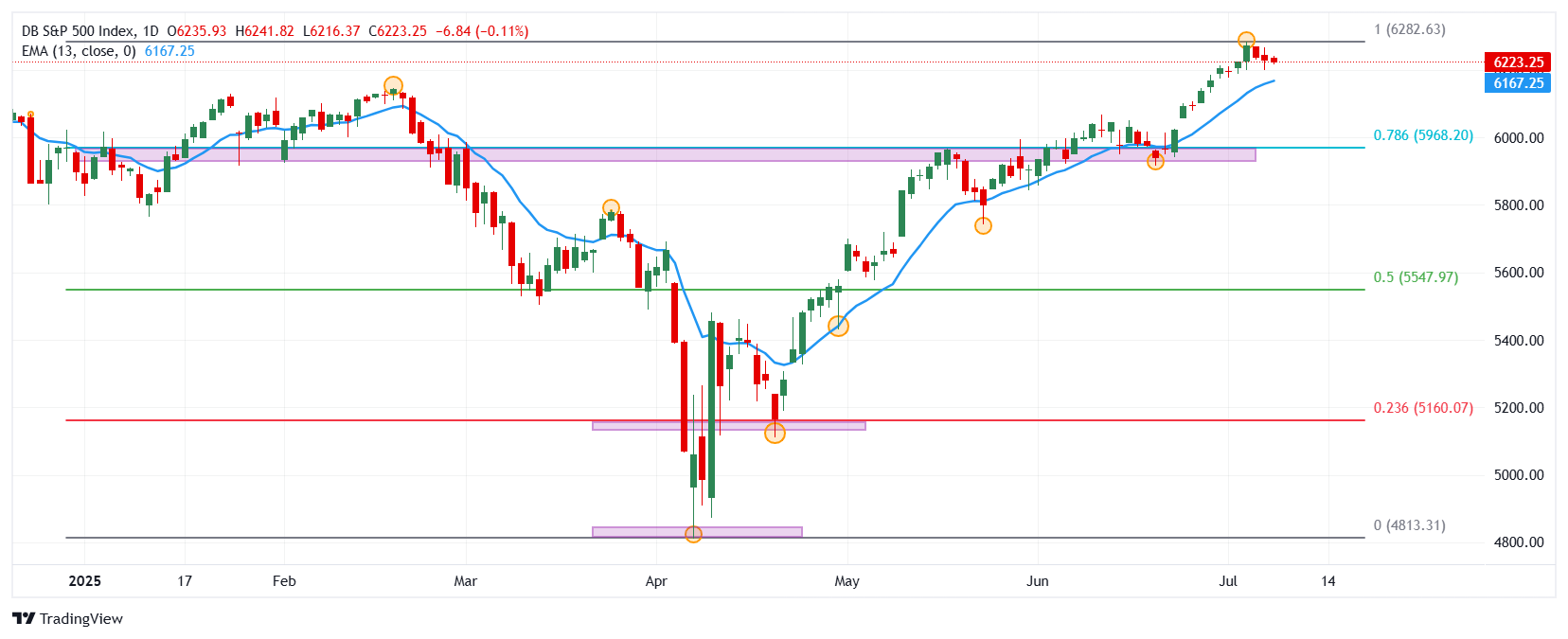- The S&P 500 stock index falls 0.11% today, consolidating within the operational range of the previous session in 6,223.
- Fair Isaac Corporation (FICO) values collapse 8.91% daily, reaching minimum not seen since May 27 in $ 1,520.
- The First Solar Titles (FSLR) decrease 6.54% on Tuesday, reaching July 2 at 165.15 $.
- Donald Trump increases tariff tensions by announcing a 50% tariff on copper imports to the United States.
- The attention of the operators will be placed in the Minutes of the Federal Reserve, to be released tomorrow.
The S&P 500 established a maximum of the day in 6,241, finding vendors that led the index to a daily minimum in 6,216. Currently, the S&P 500 is traded at 6,223, losing 0.11% in the day.
Commercial tensions resurface before Donald Trump’s tariff impositions
The president of the United States, Donald Trump, maintains a hostile commercial position towards its commercial partners, reflected in the tariff imposition of 50% over all copper imports to the United States. At the same time, additional 25% tariffs announced, especially imports from South Korea and Japan. effective as of August 1.
On the other hand, Fair Isaac Corporation (FICO) titles have a loss of 8.91% on the second day of the week, visiting minimal not seen since May 27 in $ 1,520, ending with a streak of two consecutive days upward.
In the same tonic, the actions of First Solar (FSLR) fall 6.54% daily, reaching minimum of July 2 in $ 165.15, spinning two consecutive sessions with losses.
The focus of investors will concentrate on the minutes of the Federal Reserve, in search of indications that define the rhythms of type cuts in the short term.
The S&P 500 falls 6 points in the day, operating when writing about 6,223.
Levels to be considered in the S&P 500
The S&P 500 established a short -term resistance given by the historical maximum reached on July 3 in 6,282. Down, the closest support is found in 5,917, minimum of June 19 in convergence with the recoil at 78.6% of Fibonacci. We observe the following key support in 5.430, Pivot Point of April 30.
S&P 500 DAILY GRAPH

S&P 500 – Frequently Questions
The S&P 500 is a very often stock index that measures the yield of 500 public companies and is considered a wide measure of the US stock market. The influence of each company on the calculation of the index is weighted based on stock capitalization. This is calculated by multiplying the number of bought shares of the company for the price of the action. The S&P 500 index has achieved impressive yields: 1.00 $ invested in 1970 would have produced a yield of almost $ 192.00 in 2022. The average annual profitability since its creation in 1957 has been 11.9%.
Companies are selected by committee, unlike other indices included in established standards. Even so, they must fulfill certain eligibility criteria, the most important of which is stock market, which must be equal to or greater than 12.7 billion dollars. Other criteria are liquidity, domicile, stock capitalization, sector, financial viability, quotation time and representation of the sectors of the United States economy. The nine largest companies in the index represent 27.8% of the stock market capitalization.
There are several ways to operate with the S&P 500. Most of the Stred Betting retail runners and platforms allow operators to use contracts per difference (CFD) to make bets on the price direction. In addition, indexed funds, investment funds and quoted funds (ETF) that follow the price of the S&P 500 can be purchased. The most ETF liquid is the ETF of the London Stock Exchange. The most ETF liquid is the State Street Corporation Spy. The Chicago Mercantile Exchange (CME) offers futures contracts on the index and the Chicago Board of Options (CMOE) offers options, as well as ETF, ETF Inverse and ETF leverage.
There are many factors that promote S&P 500, but mainly it is the aggregate performance of the companies that compose it, revealed in their reports of quarterly and annual results. American and world macroeconomic data also contribute, since they influence investors’ confidence, which is positive drives profits. The level of interest rates, set by the Federal Reserve (FED), also influences the S&P 500, since it affects the cost of credit, which is largely depending on many companies. Therefore, inflation can be a determining factor, as well as other parameters that influence the decisions of the Federal Reserve.
Source: Fx Street
I am Joshua Winder, a senior-level journalist and editor at World Stock Market. I specialize in covering news related to the stock market and economic trends. With more than 8 years of experience in this field, I have become an expert in financial reporting.







